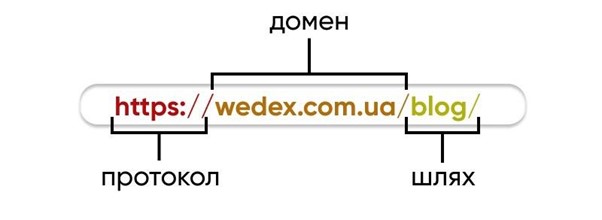Content of the article

Having a unique website address is an important part of website promotion and marketing strategy. WEDEX will tell you what a website URL is and how to choose it correctly.
What is a URL?
A URL (also known as Uniform Resource Locator) is the address of your website on the web. The term was coined by the «founding father» of the Internet, Tim Berners-Lee, back in 1990 and is still used today.
The URL address provides access to a website. In simple terms, an email address is a record of where a website is located, and the browser uses this address to provide the user with access to the website or certain materials from the server.
The email address of a website is an important component of SEO optimization. Search engines analyze not only the content of the page but also the URL that leads to it. The website’s email address should be clear and informative not only for search engines but also for users. A well-formed and optimized URL will have a positive impact on the ranking of the page in the search results and will be more likely to be found by the user.
Structure of the website email address
A URL consists of several main parts. In addition to the actual page address, the link also includes the protocol, port, domain name, and path to the page. Let’s take a closer look at each of these parts.

Protocol
A protocol is the first part of an email address. It tells the browser exactly how to interact with the server hosting the website, what data is received and what data is sent.
Most websites on the web work on two communication protocols: HTTP and HTTPS
These two protocols differ in the level of security. HTTPS is considered a modern standard and uses encrypted data transmission. HTTP is considered by some browsers and search engines to be an unreliable protocol, and users are notified of this when they try to access a website that uses this protocol.
HTTP and HTTPS are supported by default, so you don’t need to write them when entering an email address in the search box. Example: wedex.com
Domain.
The next thing in the URL is the domain name of the site. Once the browser has understood the protocol used by the link, it searches for the unique name of the site using DNS (Domain Name System). This system «translates» the domain name into an IP address that the computer can understand.
Port
The HTTP and HTTPS protocols work through ports. Ports are communication «channels» through which information is exchanged. The default ports for HTTP and HTTPS are 80 and 443, respectively.
Users usually don’t need to know or memorize the exact values of ports, because browsers can automatically substitute the above values. But if the site uses any non-standard ports, it should be specified in the URL directly.
Path
The browser has already been able to get the protocol from the URL and found the site on the server. What’s next? Next, you need to find a specific page. For this purpose, the next part of the email address is used – the so-called path. In English, this part is also called path.
From the server side, a website usually looks like a set of folders, and each individual page looks like a file. Therefore, for example, a page with the company’s history will be located at the following URL: https://example.com/about.html. But there are some nuances to this.
Features of email addresses in CMS systems
Many modern websites are powered by CMS or website builders. The most famous examples: WordPress, Weblium, Framer. These builders create pages and generate their URLs dynamically based on the records about them in the database.
Simply put, the email address on a WordPress site does not always match the actual file on the server.
URL parameters
In most cases, addresses consist of the parts described above. However, for additional settings for displaying a page or web resource, parameters can be used. They can be found at the end of the URL and, unlike the main part of the email address, they are separated not by «/» but by «?» and are separated by the «&» sign.
Anchors
Anchors are direct links to specific parts of a page. For example, we have a large long read with thirty subsections on one page of the site, and a short article that links to it on another page.
To avoid forcing the user to go to the longread page and manually search for the required location, we can generate a URL link to the page and specify a specific subsection in it.
Anchors are placed in URLs after the slash «#» and indicate the specific identifier of the object or text to which the link is made.
Types of URLs
There are generally two types of email addresses: static and dynamic. Let’s find out how they differ and what is the difference between an absolute and a relative address.
Static URL
A static email address is an unchanging address of a web resource. It contains no additional parameters and links to a page that has the same appearance for all users. As a rule, such links are simple and understandable for both users and search engines, and are better indexed.
Such URLs are used for permanent pages, i.e. for the main pages of the site: home, contacts, company information. Also, such email addresses are more search engine friendly, so they are better for SEO optimization.
Dynamic URL
A dynamic URL is generated based on the user’s request. It can contain parameters based on the query, and the «body» of the link can contain the symbols ?, &, =.
Dynamic links will be useful on the websites of large online stores, when creating personalized pages for a specific group of users, when filtering products by color, brand, price, etc.
Absolute and relative addresses
Absolute and relative URLs refer to two different types of paths to pages or files. An absolute URL is a direct link to the desired object or page. For example: https://example.com/images/logo.png. In this example, if we enter this email address into the search bar of a browser, we will see a specific image from the site.
A relative URL is a shortened path to a page or object within a website. Such an email address does not include the domain and protocol, only the direct path to the page. For example: /images/logo.png.
This type of URL is mostly used by developers or site owners to form the structure of files and folders on the server. Another example of the use of relative addresses is the creation of a link tree on the site itself.
URL formats
A link can be created in several basic formats. Let’s talk more about the advantages and disadvantages of each of them.
Transliteration
Transliteration is familiar to almost every Internet user. Websites often have URLs in this form: https://site.com/yak-stvoryty-gru. In this address, you can see the transliterated page name after the domain: «How to create a URL».
Such links are easier for search engines to perceive, so you can use transliteration in the link to your site for better page ranking. Among the disadvantages of transliteration are usually the following:
- Controversial spellings – transliteration rules do not always correspond to the norms of the modern Ukrainian language and English translations. Therefore, when transliterating a link, unpleasant incidents may occur, such as «kiev» instead of «kyiv».
- Comprehensibility – transliterated addresses are not always intuitive to native speakers. For example, «shkola» doesn’t look like «school».
- Compactness – returning to the norms of Ukrainian translation, it should be mentioned that some words, in particular place names, are not very compact, so instead of «Zaporizhzhia» the link will have a monster «zaporizhzhia».
Latin
Latinized URLs are a standard – most links on the Internet are formed from English words. This is the most common type of email address, which is most convenient and understandable for users from all over the world. Besides, search engines also rank pages with such URLs more accurately. But there are nuances:
- Knowledge of English – to create a correct Latin URL, you need to know the language. For example, «store» in English can be called both «shop» and «store» in . For better matching and better ranking, you should choose the more appropriate option.
- Loss of authenticity and clarity – if a website or page is targeted at a Ukrainian user, complex and long email addresses in English can scare off the user.
Cyrillic alphabet
It is the best choice for a Ukrainian-language website email address in terms of user understanding of the URL content. But from the SEO point of view, it’s probably the worst option. Let us explain why:
- Problems with the Cyrillic alphabet – most search engines do not work well with Cyrillic characters, and therefore the ranking of such pages will be problematic.
- SEO – SEO optimization and further promotion will be complicated by problems with indexing pages in search engines.
- Inconvenience – yes, the Cyrillic address will be understandable to the user in the browser, but when you try to copy the link, the URL will become unreadable like «%D0%BF%D1%80%».
Human-readable URL
Human-readable URLs are the best option for websites whose language is not English and whose main audience is, for example, Ukrainians. This option is optimal for SEO, reads naturally, and is formed taking into account the current rules of language transliteration. What to keep in mind when creating a URL:
- The importance of manual configuration – not all CMS translate URLs correctly, so you should manually rewrite the link for better results.
- Incorrect settings will result in long and incomprehensible addresses.
- In complex structures, especially in CMSs, there may be unnecessary duplication of words or sections in the URL: site.com/katalog/velosypedy/miski/miski-2024.
Shorten URL links
Long website URLs can be difficult to memorize. In order to make URLs shorter and easier to remember, various link shortening services are used. Among them: TinyURL, Bitly, Rebrandly, T2M. They all have the same principle of operation, but their prices and features differ.
Note: use reliable and trusted link shortening services. If the service stops working in a month or two, you’ll have to create all the shortened email addresses again.
Here are some tips for shortening URLs:
- Don’t shorten URLs in hypertext. Even if the link is long, it will still be hidden behind the main text.
- Use short addresses consciously. Shortened links are suitable for social media, emails and newsletters, or in YouTube video descriptions.
- Do not shorten the short. If the URL itself is already short, you can leave it as it is.
- Not all users trust short links, so not all of your customers will follow them.
What to look for when creating a URL for a web resource
In order for the URL to not only fulfill its task properly, but also help promote the page, you should pay attention to the following points:
- Use of keywords – the presence of keywords in an email link also affects SEO promotion. However, you shouldn’t overuse the keys, as the effect will be the opposite.
- Optimize URLs – a link that is too long is not only difficult for users to read, but also more difficult to promote. If the length of the link cannot be changed due to the technical features of the site, then use address shortening services.
- Avoid Cyrillic URLs – use transliteration as a last resort. Links with Cyrillic characters are very poorly ranked by search engines.
- Avoid unnecessary characters – the link should be concise and clear. If the URL does not require any extra parameters, do not use them and do not overload the link.
Conclusions
In this article, we’ve explained what a URL is, analyzed the structure of email addresses, learned about URL formats, and what to look for when building links. Here’s what you need to remember about URLs:
- A URL is a unique link that every page and web resource on the web has.
- An email link has several components: mandatory (protocol, domain name, page path) and optional (parameters, anchors, ports).
- The best option for URLs for non-English-language sites is semantic or long-tail. Such addresses are better indexed by search engines and understandable to the user.
- You can find the website’s email address in the search bar at the top of your browser.
- When creating a URL, keep in mind that the link should be concise, clear, and clean. Do not overload it with unnecessary characters or parameters.
Stay with WEDEX and learn about other useful online marketing tools!






 05/03/2025
05/03/2025  2219
2219



